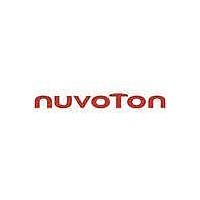NUC130LD2CN Nuvoton Technology Corporation of America, NUC130LD2CN Datasheet - Page 380

NUC130LD2CN
Manufacturer Part Number
NUC130LD2CN
Description
IC MCU 32BIT 64KB FLASH 48LQFP
Manufacturer
Nuvoton Technology Corporation of America
Series
NuMicro™ NUC100r
Specifications of NUC130LD2CN
Core Processor
ARM Cortex-M0
Core Size
32-Bit
Speed
50MHz
Connectivity
CAN, I²C, IrDA, LIN, SPI, UART/USART
Peripherals
Brown-out Detect/Reset, DMA, I²S, POR, PWM, WDT
Number Of I /o
35
Program Memory Size
64KB (64K x 8)
Program Memory Type
FLASH
Eeprom Size
-
Ram Size
8K x 8
Voltage - Supply (vcc/vdd)
2.5 V ~ 5.5 V
Data Converters
A/D 8x12b
Oscillator Type
Internal
Operating Temperature
-40°C ~ 85°C
Package / Case
48-LQFP
Lead Free Status / Rohs Status
Lead free / RoHS Compliant
Available stocks
Company
Part Number
Manufacturer
Quantity
Price
Company:
Part Number:
NUC130LD2CN
Manufacturer:
Nuvoton Technology Corporation of America
Quantity:
10 000
Part Number:
NUC130LD2CN
Manufacturer:
NUVOTON
Quantity:
20 000
- Current page: 380 of 571
- Download datasheet (5Mb)
5.13.6.7 Configuring a FIFO Buffer
5.13.6.8 Receiving Messages with FIFO Buffers
5.13.6.8.1 Reading from a FIFO Buffer
If the Message Object uses masks for acceptance filtering, the arbitration bits shows which of the
matching messages have been received.
The actual value of NewDat shows whether a new message has been received since the last
time this Message Object was read. The actual value of MsgLst shows whether more than one
message has been received since the last time this Message Object was read. MsgLst will not be
automatically reset.
By means of a Remote Frame, the software may request another CAN node to provide new data
for a receive object. Setting the TxRqst bit of a receive object will cause the transmission of a
Remote Frame with the receive object’s identifier. This Remote Frame triggers the other CAN
node to start the transmission of the matching Data Frame. If the matching Data Frame is
received before the Remote Frame could be transmitted, the TxRqst bit is automatically reset.
With the exception of the EoB bit, the configuration of Receive Objects belonging to a FIFO Buffer
is the same as the configuration of a (single) Receive Object, see Section 5.13.6.5: Configuring a
Receive Object.
To concatenate two or more Message Objects into a FIFO Buffer, the identifiers and masks (if
used) of these Message Objects have to be programmed to matching values. Due to the implicit
priority of the Message Objects, the Message Object with the lowest number will be the first
Message Object of the FIFO Buffer. The EoB bit of all Message Objects of a FIFO Buffer except
the last have to be programmed to zero. The EoB bits of the last Message Object of a FIFO
Buffer is set to one, configuring it as the End of the Block.
Received messages with identifiers matching to a FIFO Buffer are stored into a Message Object
of this FIFO Buffer starting with the Message Object with the lowest message number.
When a message is stored into a Message Object of a FIFO Buffer, the NewDat bit of this
Message Object is set. By setting NewDat while EoB is zero, the Message Object is locked for
further write access by the Message Handler until the application software has written the NewDat
bit back to zero.
Messages are stored into a FIFO Buffer until the last Message Object of this FIFO Buffer is
reached. If none of the preceding Message Objects is released by writing NewDat to zero, all
further messages for this FIFO Buffer will be written into the last Message Object of the FIFO
Buffer and therefore overwrite previous messages.
When the application software transfers the contents of a Message Object to the IFn Message
Buffer register by writing its number to the IFn Command Request Register, the corresponding
Command Mask Register should be programmed in such a way that bits NewDat and IntPnd are
reset to zero ( TxRqst / NewDat = ‘1’ and ClrIntPnd = ‘1’). The values of these bits in the Message
Control Register always reflect the status before resetting the bits.
To assure the correct function of a FIFO Buffer, the application software should read the Message
Objects starting at the FIFO Object with the lowest message number.
Figure 5-82 shows how a set of Message Objects which are concatenated to a FIFO Buffer can
be handled by the application software.
NuMicro™ NUC130/NUC140 Technical Reference Manual
- 380 -
Publication Release Date: June 14, 2011
Revision V2.01
Related parts for NUC130LD2CN
Image
Part Number
Description
Manufacturer
Datasheet
Request
R

Part Number:
Description:
Manufacturer:
Nuvoton Technology Corporation of America
Datasheet:

Part Number:
Description:
Manufacturer:
Nuvoton Technology Corporation of America
Datasheet:

Part Number:
Description:
Manufacturer:
Nuvoton Technology Corporation of America
Datasheet:

Part Number:
Description:
Manufacturer:
Nuvoton Technology Corporation of America
Datasheet:

Part Number:
Description:
Manufacturer:
Nuvoton Technology Corporation of America
Datasheet:

Part Number:
Description:
Manufacturer:
Nuvoton Technology Corporation of America
Datasheet:

Part Number:
Description:
Manufacturer:
Nuvoton Technology Corporation of America
Datasheet:











